183 books about Economics & Trade and 10
start with A
183 books about Economics & Trade and 10
183 books about Economics & Trade
10 start with A start with A
10 start with A start with A

After Neoliberalism
What Next for Latin America?
Lance Taylor, Editor
University of Michigan Press, 1999
In the past twenty years, economic policy in Latin America has veered toward neoliberalism, or market friendliness. State interventions in the economy were cut back in many areas, in the form of reductions in fiscal deficits; privatization of public enterprises; reductions of import quotas and tariffs and export subsidies; removal of barriers to foreign capital flow; and increased faith in the private sector and market processes.
This book offers an intellectual and historical background for these policy choices, specifically in Argentina, Brazil, Chile, Colombia, Mexico, and Peru. The contributors detail the structural reform and economic policies in Latin America and discuss the various and often contradictory effects neoliberalism, such as fluctuating growth rates and saving-investment balances, worsened corruption, growth of exports, falling wages, and rising unemployment. In addition, each case study forecasts the effects of neoliberal policies on future growth and income distribution in the respective countries. Finally, it offers policy alternatives to neoliberalism.
The essays in this volume are: an introduction by Lance Taylor; "The Argentine Experience with Stabilization and Structural Reform," by José María Fanelli and Roberto Frenkel; "Opening, Stabilization, and Macroeconomic Sustainability in Brazil," by Edward Amadeo, "An Ongoing Structural Transformation: The Colombian Economy, 1986-96," by José Antonio Ocampo; "Economic Reforms, Stabilization Policies, and the 'Mexican Disease,'" by Nora Claudia Lustig and Jaime Ros; and "Structural Reforms and Macroeconomic Policy in Peru: 1990-96," by Oscar Dancourt.
Lance Taylor is the Arnhold Professor of International Cooperation and Development, New School for Social Research.
This book offers an intellectual and historical background for these policy choices, specifically in Argentina, Brazil, Chile, Colombia, Mexico, and Peru. The contributors detail the structural reform and economic policies in Latin America and discuss the various and often contradictory effects neoliberalism, such as fluctuating growth rates and saving-investment balances, worsened corruption, growth of exports, falling wages, and rising unemployment. In addition, each case study forecasts the effects of neoliberal policies on future growth and income distribution in the respective countries. Finally, it offers policy alternatives to neoliberalism.
The essays in this volume are: an introduction by Lance Taylor; "The Argentine Experience with Stabilization and Structural Reform," by José María Fanelli and Roberto Frenkel; "Opening, Stabilization, and Macroeconomic Sustainability in Brazil," by Edward Amadeo, "An Ongoing Structural Transformation: The Colombian Economy, 1986-96," by José Antonio Ocampo; "Economic Reforms, Stabilization Policies, and the 'Mexican Disease,'" by Nora Claudia Lustig and Jaime Ros; and "Structural Reforms and Macroeconomic Policy in Peru: 1990-96," by Oscar Dancourt.
Lance Taylor is the Arnhold Professor of International Cooperation and Development, New School for Social Research.
[more]
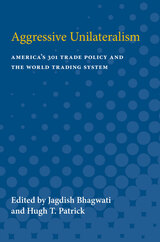
Aggressive Unilateralism
America's 301 Trade Policy and the World Trading System
Jagdish Bhagwati and Hugh T. Patrick, Editors
University of Michigan Press, 1990
United States trade policy has moved in recent years toward aggressive unilateralism. This volume provides the most comprehensive, coherent, and insightful analysis of this dramatic development. The essays collected here explain the legislative history of this policy as expressed in Section 301 and the more recent Super 301 and explore the political forces driving their adoption on Capitol Hill. The targeting of Japan, India, and Brazil by the administration using Super 301 powers is discussed, as are the reactions of those countries to this targeting. These American actions raise questions about the legality of such tariff retaliation under GATT rules and about America’s simultaneous support of multilateral talks at the Uruguay Round intended to reconstitute and revitalize the GATT.
[more]

American Universities in a Global Market
Edited by Charles T. Clotfelter
University of Chicago Press, 2010
In higher education, the United States is the preeminent global leader, dominating the list of the world’s top research universities. But there are signs that America’s position of global leadership will face challenges in the future, as it has in other realms of international competition. American Universities in a Global Market addresses the variety of issues crucial to understanding this preeminence and this challenge. The book examines the various factors that contributed to America’s success in higher education, including openness to people and ideas, generous governmental support, and a tradition of decentralized friendly competition. It also explores the advantages of holding a dominant position in this marketplace and examines the current state of American higher education in a comparative context, placing particular emphasis on how market forces affect universities. By discussing the differences in quality among students and institutions around the world, this volume sheds light on the singular aspects of American higher education.
[more]
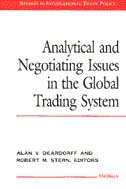
Analytical and Negotiating Issues in the Global Trading System
Alan Deardorff and Robert M. Stern, Editors
University of Michigan Press, 1994
This title was formally part of the Studies in International Trade Policy Series, now called Studies in International Economics.
[more]
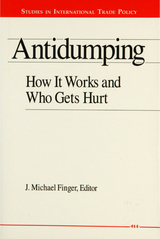
Antidumping
How It Works and Who Gets Hurt
J. Michael Finger
University of Michigan Press, 1993
Antidumping is a threat to the liberal trading system that post-World War II Western leadership struggled courageously and effectively to create. It offers a GATT-legal means to destroy the GATT system, leading to restrictions on more U.S. imports than even the Multi-Fibre Arrangement. This book presents studies of five industries whose exports have been hard hit by antidumping actions. Each of these studies avoids the legalisms and the jargon of antidumping and answers a straightforward question: was the national economic interest of either the exporting or the importing country improved by the antidumping actions that were taken? The contributors not only ask questions and present viable answers, but also provide a proposal that offers both consistence with GATT and good economics.This book will be of interest to lawyers, political scientists, economists, and business people. It has intentionally avoided the specialized language of trade regulation so that it may be more readily accessible to anyone interested in international commercial policy.
[more]

Antidumping Law
John H. Jackson
University of Michigan Press, 1979
Few issues in international trade display a volatility like that of antidumping law. In Antidumping Law: Policy and Implementation the practitioner will find thoughtful expositions of current administration of the laws. Instructive analyses of International Trade Commission standards, the “fast track” procedure, and judicial review of ITC and the Department of Treasury determinations are presented. The Appendix offers an invaluable resource for United States and foreign antidumping law scholars and practitioners.
[more]
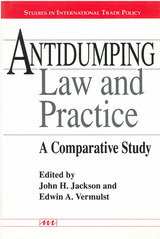
Antidumping Law and Practice
A Comparative Study
John H. Jackson and Edwin A. Vermulst, Editors
University of Michigan Press, 1990
This title was formally part of the Studies in International Trade Policy Series, now called Studies in International Economics.
[more]

Assessing the Value of Law in Transition Economies
Peter Murrell, Editor
University of Michigan Press, 2001
Does law play a role in the economies that are moving from Soviet-style socialism to market capitalism? The essays in this book examine that question, providing a vivid picture of how the new institutions of capitalism affect the lives of business people, legal practitioners, investors, and bureaucrats. They analyze the determinants of successful institutional reform, suggesting that law can influence economic behavior even in inhospitable environments. Contributors--including economists, political scientists, and legal and business scholars--examine the pathways through which legal and institutional reforms affect behavior and identify the circumstances under which such reforms add value. They ask: What are the microeconomic mechanisms by which law contributes to the activities of economic agents? How do the characteristics of economic agents affect their ability to use the law? Which spheres of the economy are most affected by institutional reforms and where does law fail? What are the preconditions for effective legal and institutional reforms? Which types of political processes produce a workable system of economic legislation? The focus throughout is on the analysis of the individual economic agent who is subject to the new institutions, and thus the decisions of the individual actor, the shopkeeper, the lawyer, the court, the legislator-politician, the enterprise, the bureaucrat, the regulatory authority, and the outside investor. There are lessons on research methodology, on the economic role of institutions, and on the practice of institutional development. The focus is on the transition economies, but the conclusions and methodologies are pertinent when understanding the role of law in any context. The book will be important reading for scholars and practitioners with a wide range of interests and in a wide range of disciplines and of interest to all those concerned with economic, legal, and institutional development, economists, political scientists, lawyers, and development specialists alike.
[more]

At Home and Abroad
U.S. Labor Market Performance in International Perspective
Francine D. Blau
Russell Sage Foundation, 2002
Throughout the latter part of the 20th century, the U.S. labor market performed differently than the labor markets of the world's other advanced industrialized societies. In the early 1970s, the United States had higher unemployment rates than its Western European counterparts. But after two oil crises, rapid technological change, and globalization rocked the world's economies, unemployment fell in the United States, while increasing dramatically in other nations. At the same time, wage inequality widened more in the United States than in Europe. In At Home and Abroad, Cornell University economists Francine D. Blau and Lawrence M. Kahn examine the reasons for these striking dissimilarities between the United States and its economic allies. Comparing countries, the authors find that governments and unions play a far greater role in the labor market in Europe than they do in the United States. It is much more difficult to lay off workers in Europe than in the United States, unemployment insurance is more generous in Europe, and many fewer Americans than Europeans are covered by collective bargaining agreements. Interventionist labor market institutions in Europe compress wages, thus contributing to the lower levels of wage inequality in the European Union than in the United States. Using a unique blend of microeconomic and microeconomic analyses, the authors assess how these differences affect wage and unemployment levels. In a lucid narrative, they present ample evidence that, as upheavals shook the global economy, the flexible U.S. market let wages adjust so that jobs could be maintained, while more rigid European economies maintained wages at the cost of losing jobs. By helping readers understand the relationship between different economic responses and outcomes, At Home and Abroad makes an invaluable contribution to the continuing debate about the role institutions can and should play in creating jobs and maintaining living standards.
[more]
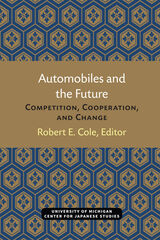
Automobiles and the Future
Competition, Cooperation, and Change
Robert E. Cole, Editor
University of Michigan Press, 1983
At the time of the U.S.-Japan auto conferences in March 1983, the hoped-for economic recovery as manifested in auto sales had revealed itself quite modestly. Three months later, the indicators were more robust and certainly long overdue for those whose livelihood depends on the health of the industry--some of whom are university professors.
With Japanese import restrictions in place until March 1984 and drastically reduced break-even points for domestic manufactures, rising consumer demand holds great promise for the industry. The rapidly rising stock prices of the auto-makers captures well the sense of heightened optimism, as do the various forecasts for improved profits.
While the news is certainly welcome, it nevertheless should be greeted with caution. As Mr. Perkins noted at the conference, "we have a tendency to forget things very quickly. If we have a boom market this year, there is a good chance that a lot of things we learned will be forgotten."
To put the matter differently and more bluntly, with growing prosperity there is the risk that management will fall back into old habits, making impossible the achievement of sustained quality and productivity improvement. Similarly, the commitment to develop cooperative relations with workers and suppliers will weaken. The union will be under membership pressure to retrieve concessions rather than to take the longer-term view. This longer-term view recognizes that "up-front increases" and adherence to existing work rules increasingly come at the sacrifice of future job security. Government policymakers will turn their attention away from the industry. This may not mean a great deal given how weakly focused their attentions has been during the last three years and how mixed and contradictory government auto policies have been for over a decade.
[more]
READERS
Browse our collection.
PUBLISHERS
See BiblioVault's publisher services.
STUDENT SERVICES
Files for college accessibility offices.
UChicago Accessibility Resources
home | accessibility | search | about | contact us
BiblioVault ® 2001 - 2025
The University of Chicago Press









